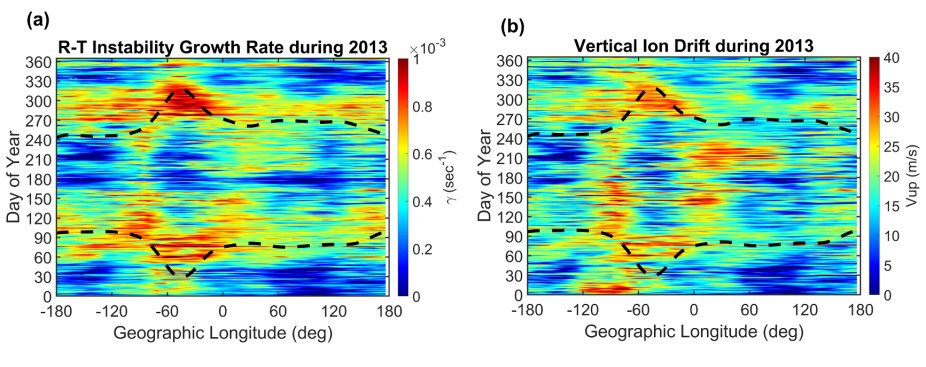
Seasonal and longitudinal variations of (a) R-T growth rate and (b) vertical ion drift during 2013 driven by observed solar and interplanetary parameters. The dashed lines represent the days when the solar terminator aligns with the magnetic field line.
Journal of Geophysical Research, Space Physics: An expression of Rayleigh-Taylor (R-T) instability growth rate based on the field-line integrated theory is newly established. This expression can be directly utilized in ionosphere models with magnetic flux tube structure based on Modified Apex Coordinates. In this study, the R-T instability growth rates are calculated using the thermospheric and ionospheric conditions based on the coupled Whole Atmosphere Model and Ionosphere Plasmasphere Electrodynamic model (WAM-IPE). The parameters used in this calculation include the field-line integrated conductivities and currents, which consider the Quasi-Dipole Coordinates and the modifications to the equations of electrodynamics. Detailed description of the new formulas and comprehensive analyses of diurnal, longitudinal, and seasonal variations of the R-T instability growth rate are carried out. The dependencies of growth rates on pre-reversal enhancement (PRE) vertical drifts and solar activity are also examined. The results show that pronounced R-T growth rates are captured between 18 and 22 local time (LT) when strong PRE occurs in the equatorial ionosphere. The simulated R-T growth rate increases with increasing solar activity levels and demonstrates strong correlations with the angle between the sunset terminator and the geomagnetic field line. These results are consistent with plasma irregularity occurrence rates shown in various satellite observations, suggesting that the newly developed R-T growth rate calculation can effectively capture the probability of irregularities by considering the changes along magnetic flux-tubes in the ionosphere. Since the WAM-IPE is running in operation at NOAA Space Weather Prediction Center (SWPC), the new calculations can be potentially implemented in the near future to provide forecasted information of the R-T growth rate.